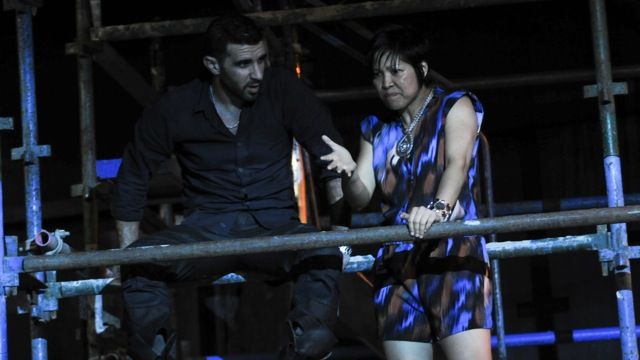Buried City
In keeping with its raw characters and themes, this is a raw production. It pulls no punches. It makes no excuses. So, if you don’t like straight talking with ubiquitous four letter words from characters who say it like it is, it may be possible that you won’t like Buried City. On the other hand, because the characters depict their own reality, in their own ‘speak’, the language they use shouldn’t really offend. They speak of their present, grubby as it is; they speak of their hopes, unachievable as they may seem; and it is all viscerally real.
The urban set (Mirabelle Wouters, designer) is a section of a closed building site. Bounded by scaffolding, it is littered with detritus – odd chairs, milk crates, buckets, empty bottles, rope – and overseen by a site office.
The lighting (Neil Simpson designer, with Sean Bacon) is dim, adding to the sense of squalor. Street lights flicker through an open door; a TV in the office reflects on the wall; dulled spots pinpoint some of the action, but the overall effect is dim. At times the audience strains to see the action.

Composer and sound designer, Paul Prestino, establishes the setting with a constant background of street ‘music’. A conglomeration of sounds that are almost recognisable that fade to others that aren’t. The ‘white noise’ of the city.
In this setting, the characters emerge. They work hard throughout, as does the audience, as they follow their disjointed conversations and feel their anger and disappointments and fears.
Strongest of all is Meyne Wyatt, the young indigenous actor who made such an impact on the Sydney theatre scene in 2011 (The Brothers Size and Silent Disco at Griffin and Bloodland at STC). Playing a young worker, Meyne’s physical stage presence is remarkable. He moves with the grace of his aboriginal heritage, yet mixes this with the irritable restlessness of city youth. Even when he is completely still, he gives the impression of constant awareness, watchful, like a gazelle ready to spring. He brings lively humour and comic relief to the action – and a perceptive commentary on the other characters and their complaints and fears.
As the dissatisfied, trade unionist worker, Russell Kiefel shows the wealth of his acting experience. He is the constant of the production, changing and holding the pace, linking the characters, and totally real in his depiction of disappointment and hopelessness.
Hazem Shammas is strong and physical as the disillusioned young son of a migrant family. His restless physicality sees him climbing scaffolding, luring Russell to a fist fight, always on the move. He brings with him to the scene a girl he has picked up. Played by Valerie Berry, she is similarly restless, searching for something to fill the nights when she can’t sleep.
Effie (Effie Nkrumak), as the efficient, self-confident security guard is unremarkable really until a fast and funny scene mid way through the 80 minute production. Here her physicality and pace show much more of her talent.
Perry Keyes, as the guitar playing, singing taxi driver, wanders around the edge of everyone’s reality, searching for something, though we never really know quite what.

In fact, when the play ends, we it’s hard to say exactly what it’s about. Even reading the notes from writer Raimondo Cortese and director Alicia Talbot doesn’t clarify a definite single theme. Is it change? Is it disillusion? Is it fear of a future fraught with economic insecurity? Is it loneliness in a world too busy to care? It is all of these? Perhaps so. Writing about it has made me feel that maybe I understand it a little better. Maybe.
As far as direction is concerned, there are some compelling moments and some lovely little bits of fun – for instance when Russell balances a bottle on a skateboard and pushes it across the stage to Perry! There is much restless movement that in another production could be seen as upstaging. Here it is the hub of the action. The use of the whole stage allows each character to reach out to another, sometimes to taunt, sometimes to threaten, sometimes to advise or help, yet always to maintain personal space.
The ending is strange. It is frenzied and then the frenzy stops. There is no clear realisation that the play is over, no resolution .. ah, but perhaps that’s what it’s all about.
Carol Wimmer
Images: Hazem Shammas and Valerie Berry; Russell Kiefel & Effie Nkrumah. Photographer: Heidrun Lohr.
To keep up with the latest news and reviews at Stage Whispers, click here to like us on Facebook, or follow us on Twitter.
Subscribe to our E-Newsletter, buy our latest print edition or find a Performing Arts book at Book Nook.

